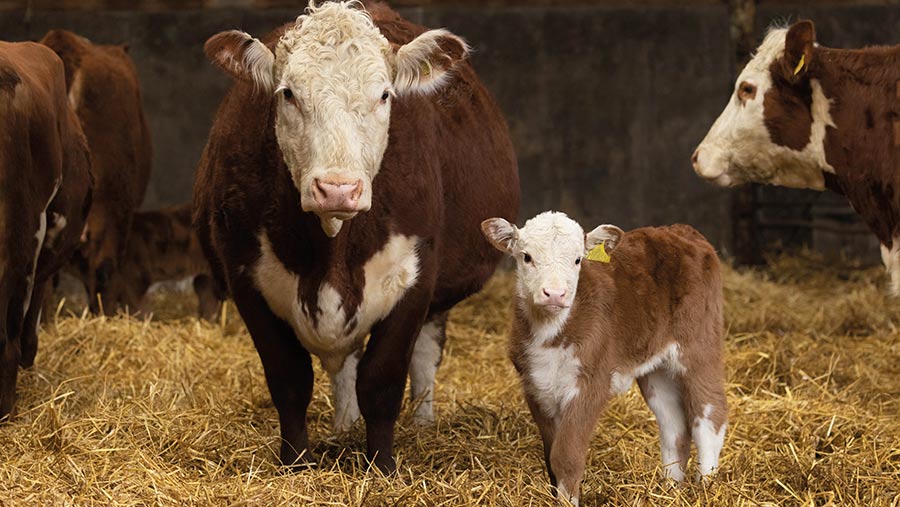4 essential checks to improve suckler herd efficiency
 © Tim Scrivener
© Tim Scrivener Measuring and monitoring herd performance is vital for improving the health, efficiency and profitability of a suckler herd.
The aim of a suckler system is to produce as many kilos of calf to each kilo of cow every year, while managing input costs.
Performance data can be less accessible in suckler herds than dairy herds, but this is no excuse not to record cattle weights – and analysing the data does not need to be complicated.
See also: How to manage difficult calvings in beef cattle
About the author
Each month, we bring practical advice from an XLVets practice on a range of different subjects. Here, Guy Tomlinson, from Daleside Veterinary Group, explains how using the herd efficiency key performance indicator can help identify areas for improvement.
Weigh scales are inexpensive and investing in safe and efficient handling facilities pays for itself very quickly.
In addition, collecting and recording cattle weights can usually be done alongside other management tasks when the cattle are already being handled.
The AHDB herd efficiency key performance indicator (KPI) is a good gauge of a herd’s overall performance.
It is a measure of the calf’s weight at 200 days of age as a percentage of the cow’s weight. This is calculated by weighing cows and calves at weaning and adjusting the calf’s weight to what it would be at 200 days of age.
The goal is to achieve more than 50%, but this can be tough to attain – so, if a herd is achieving more than 45%, it is performing well.
The herd efficiency KPI can be used to assess the herd’s average performance, as well as compare individual cows within the herd.
It is influenced by all aspects of herd health and management – fertility, calf health, nutrition and genetics.
Improving herd efficiency requires drilling down into the individual areas that influence it, then focusing on improving any areas of underperformance.
1. Fertility
For a tight calving block, cows should be mated for nine weeks. This allows the cows three cycles to get in-calf.
Targets
- Less than 5% of cows that are eligible for service empty at the end of mating
- 75-85% of eligible cows calve within the first six weeks of the calving period.
Improvements
Fertility can be influenced by nutrition, management and infectious diseases.
By the time a fertility problem is detected, it is often difficult to correct for that year, which also makes it harder to achieve a tight calving block the following year.
- Work with your vet to ensure cows are in tip-top health ahead of mating. This is key to achieving and maintaining good results
- Ensure the previous calving runs smoothly – cows that calve early in the previous block without any issues get back in-calf more easily
- Ensure cows are in optimum body condition score at calving
- Fertility-test bulls two months before mating
- Metricheck each cow about three weeks post-calving to detect and treat any cows with metritis or endometritis
- Start heat detection three to four weeks pre-mating using heat detection aids
- At the start of mating, check any cows not seen in heat with the vet. They can then be treated or synchronised to ensure they have a heat and are served as early as possible
- Scan cows for pregnancy eight weeks into mating. This will detect the cows that conceived during the first three weeks of mating. At this point, you should aim for 55-60% of eligible cows to be in-calf, to be on target to achieve 75-85% of eligible cows calving in the first six weeks
- Scan the remaining cows after the end of mating to assess the spread of predicted calving in the block, and then cull any barren cows after weaning.
2. Nutrition
Good, cost-effective nutrition is essential for good fertility to ensure the cow produces plenty of milk for her calf to grow and to maintain body condition.
Targets
- Cows should have a body condition score (BCS) of 2.5-3 at calving
- Cows should have a BCS of 2.5 at mating.
Improvements
Dry cow and transition cow diets are key to setting the cow up for the following lactation
- Dry cow and transition cow diets are key to preparing the animal for the following lactation
- Dry cows in the correct body condition should only require enough energy for maintenance until the last three weeks pre-calving, when it will increase to 1.2 x maintenance
- The balance of salts (dietary cation anion balance) is also key in the last three weeks pre-calving to reduce the risk of milk fever
- Spring-calving herds should maximise grass use by matching grass availability and quality to the peak nutrition demand of the cow
- Rotational grazing maximises grass utilisation, quality and quantity
- Measuring the cow’s BCS at key stages, such as pre-calving, pre-mating and pre-weaning, is vital to managing nutrition
- It is also important to monitor trace elements and minerals through forage analysis and blood testing.
3. Calf Health
Infectious diseases can have a life-long impact on the growth rate of calves. The most common health issues affecting calves are scour and pneumonia.
Targets
- A mortality in calves of less than 5% from birth to weaning.
Improvements
- Monitor disease incidence and investigate the cause
- Put a prevention plan in place with your vet to prevent poor calf health from impacting on performance.
4. Genetics
It is important to select appropriate genetic traits for the job.
There are two types of traits when it comes to estimated breeding values (EBVs): maternal traits for females, such as fertility, milk ability and calving ease, stature and maintenance; and terminal traits required for the calf, such as growth rates and carcass conformation.
Improvements
- Have clear breeding goals
- Use EBVs to select the desired traits for your herd
- Use easy-calving bulls.
